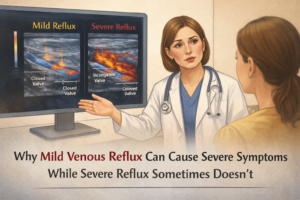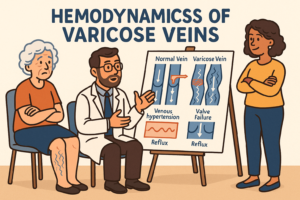Vein mapping ultrasound is a diagnostic procedure that plays a crucial role in the treatment of various vascular conditions, particularly those involving the veins in the legs. It involves the use of ultrasound technology to create a detailed map of the veins in a specific area of the body, most commonly the legs. This map helps healthcare providers assess the health and function of the veins by ensuring proper blood flowing through them, plan surgical procedures, and guide treatments such as vein ablation or sclerotherapy. In this blog, we’ll explore what vein mapping is, how it’s performed, and why it’s an essential tool in vascular care.
What Is Vein Mapping?
Vein mapping is a non-invasive imaging technique that provides a visual representation of the veins in a specific area of the body. It is primarily used to evaluate the veins in the legs, especially when planning treatments for varicose veins, spider veins, or other venous disorders. The procedure is typically performed using duplex ultrasound, which combines traditional ultrasound with Doppler imaging to assess both the structure of the veins and the blood flowing within them. This involves the use of B-mode ultrasound to create two-dimensional images of vein structures and high frequency sound waves to generate real-time images of blood flow, aiding in various medical procedures related to venous health.
Why Is Vein Mapping Done?
Vein mapping is an essential diagnostic tool for several reasons:
Maintaining healthy blood flowing through the venous system is crucial, as it ensures proper function and prevents issues like venous insufficiency. Vein mapping helps in this assessment by identifying any blood flow issues and ensuring the proper function of the venous structures.
Vein mapping aids in various medical procedures by identifying suitable veins for non-invasive interventions, enhancing the success and efficiency of these treatments.
Assessment of Vein Health and Blood Flow
Vein mapping allows healthcare providers to assess the size, location, and condition of the veins, ensuring proper blood flowing through them. It helps identify any abnormalities, such as vein blockages, valve dysfunction, or varicose veins. By visualizing the veins in detail, providers can better understand the extent of venous disease and determine the most appropriate treatment options. Assessing the great saphenous vein is particularly important during vein mapping, as it helps evaluate the function and health of this key vein and its suitability for treatments such as laser therapy.
2. Surgical Planning
For patients undergoing procedures such as vein stripping, vein ablation, or bypass surgery, vein mapping is invaluable in planning the surgery. It helps surgeons identify the best veins to use in the procedure and avoid areas with damaged or insufficient veins. This precise mapping ensures that the surgery is as effective and minimally invasive as possible.
Additionally, the use of compression stockings in pre- or post-surgical care for venous conditions is crucial. They help alleviate symptoms, improve circulation, and enhance the overall quality of life for patients, following a physician’s guidance for the best outcomes.
Guidance for Minimally Invasive Treatments of Varicose Veins
In minimally invasive treatments like sclerotherapy or endovenous laser therapy (EVLT), vein mapping provides a roadmap that guides the placement of catheters or injections. By knowing exactly where the veins are located and how blood is flowing through them, healthcare providers can target treatment areas with greater accuracy, improving outcomes and reducing the risk of complications.
4. Monitoring Disease Progression
Venous mapping can also be used to monitor the progression of venous disease over time. Regular vein mapping helps in monitoring blood flowing and tracking changes in vein health over time. For patients with chronic conditions such as chronic venous insufficiency (CVI), regular vein mapping can help track changes in vein health and guide adjustments to treatment plans.
How Is Vein Mapping Performed?
Vein mapping is a straightforward and painless procedure. Here’s what you can expect during a typical vein mapping session:
An ultrasound machine, which transmits high-frequency sound waves through body tissues to create videos or photos of blood vessels and fluids, is used to record the speed of blood flowing and reflect sound waves off moving blood cells. The ultrasound transducer, a hand-held device, plays a crucial role in this non-invasive procedure by transmitting high-frequency sound waves to create detailed images of veins while applying pressure along the legs to ensure minimal discomfort for the patient.
1. Preparation
The patient is usually asked to lie down on an examination table, although in some cases, the procedure may be performed with the patient standing to better visualize the veins under the influence of gravity. No special preparation is required for the procedure; patients can eat and drink normally, and only practical steps like changing into a hospital gown and removing jewelry are necessary. The area to be mapped, typically the legs, will be exposed and may be cleaned with a gel that helps the ultrasound device make better contact with the skin.
Ultrasound Imaging with an Ultrasound Probe
A trained technician or vascular specialist will use an ultrasound probe to scan the area. The procedure can be performed on the upper or lower extremities to assess conditions such as venous insufficiency and to determine the presence of blockages or thrombus in the veins. The probe emits sound waves that bounce off the blood vessels and are then captured to create an image. The Doppler function of the ultrasound measures the speed and direction of blood flowing within the veins, providing a comprehensive view of their function.
3. Creating the Vein Map
As the technician moves the probe along the length of the leg, images are captured and recorded. These images are used to create a detailed map of the veins, showing their size, shape, and location. The map also highlights any areas where blood flowing is impaired or where the veins have become enlarged or twisted.
4. Interpretation
Once the mapping is complete, the images are reviewed by a vascular specialist who will interpret the results. They will look for any signs of venous disease or abnormalities and use the map to plan further treatment or surgery if necessary.
Who Should Consider Vein Mapping?
Vein mapping is recommended for individuals who: Maintaining healthy blood flowing through the venous system is crucial, as it ensures proper function and prevents issues like venous insufficiency. Vein mapping helps assess blood flow and the function of venous structures.
Have symptoms of venous disease: Such as swelling, pain, or visible varicose veins in the legs.
Are planning vein surgery or minimally invasive treatments: To ensure the most effective and safe procedure.
Have a history of venous disorders: Including chronic venous insufficiency or deep vein thrombosis (DVT).
Need vascular access for procedures: Such as dialysis or chemotherapy, where healthy veins must be identified for catheter placement.
Benefits of Vein Mapping
Vein mapping offers numerous benefits for both patients and healthcare providers. Maintaining healthy blood flowing through the venous system is crucial, and vein mapping helps assess blood flow issues to ensure proper function within the venous structures.
Improved Treatment Outcomes: By providing a detailed map of the veins, healthcare providers can perform more precise and effective treatments.
Reduced Risk of Complications: Accurate mapping helps avoid unnecessary damage to healthy veins and reduces the risk of complications during procedures.
Customized Treatment Plans: Vein mapping allows for personalized treatment plans tailored to the specific needs and conditions of each patient.
Non-Invasive and Painless: The procedure is non-invasive, painless, and requires no downtime, making it an easy and convenient option for patients.
Conclusion
Vein mapping is a valuable diagnostic tool in the management and treatment of venous disorders. Whether you’re planning a surgical procedure, considering minimally invasive treatments, or simply monitoring the health of your veins, vein mapping provides the detailed information necessary for successful outcomes. If you’re experiencing symptoms of venous disease or have been recommended for vein mapping by your healthcare provider, understanding the process and its benefits can help you make informed decisions about your vascular health.









